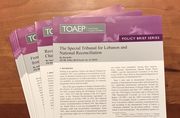Table of contents:
Element:
3. The perpetrator destroyed or seized certain property.
3.1. The perpetrator destroyed certain property; OR
In Kordić and Čerkez, the Trial Chamber stated that:
"(i) the destruction of property occurs on a large scale; (ii) the destruction is not justified by military necessity; and (iii) the perpetrator acted with the intent to destroy the property in question or in reckless disregard of the likelihood of its destruction"[1]
The Trial Chamber in Gotovina et al. held that:
"The charges of plunder of public or private property, and wanton destruction of cities, towns or villages or devastation not justified by military necessity, are based on rules of customary international law applicable in both international and non-international armed conflict. Such wanton destruction or devastation breaches rules protecting important values and involves grave consequences for the victims. The prohibition on plunder of public or private property protects important values, but a case-by-case assessment is necessary to determine whether such acts involve grave consequences for the victims. This would always be the case where the plunder concerns the property of a large number of people, even in the absence of grave consequences for each individual. Both plunder and wanton destruction, as referred to above, entail individual criminal responsibility. The Trial Chamber therefore has jurisdiction over such violations, except to the extent that plunder cannot be shown to involve grave consequences for the victims."[2]
3.2. The perpetrator seized certain property.
The Trial Chamber in Stanisic and Zupljanin held that:
"The plunder of public or private property is a war crime under Article 3(e) of the Statute. 'Acts of plunder, which have been deemed by the International Tribunal to include pillage, infringe various norms of international humanitarian law.' The Trial Chamber considers that 'looting' is also included in the crime of plunder of property."[3]
"The Appeals Chamber has held that there is a consequential link between the monetary value of the appropriated property and the gravity of the consequences for the victim, stressing that the assessment of when a piece of property reaches the threshold level of a certain value can only be made on a case-by-case basis and only in conjunction with the general circumstances of the crime."[4]
The Trial Chamber in Gotovina et al. stated that:
"As to the first element, all forms of seizure of public or private property constitute acts of appropriation, including isolated acts committed by individual soldiers for their private gain and acts committed as part of a systematic campaign to economically exploit a targeted area."[5]
Footnotes:
[1] ICTY, Kordić and Čerkez Trial Judgment 26 February 2001, para. 346. See also ICTY, Naletilić and Martinović Trial Judgment 31 March 2003, para. 579.
[2] ICTY, Gotovina et al. Trial Chamber Judgment 15 April 2011, para. 1672 .
[3] ICTY, Prosecutor v. Stanisić and Župljanin, "Judgment", IT-08-91-T, 27 March 2013, para. 83.
[4] ICTY, Prosecutor v. Stanisić and Župljanin, "Judgment", IT-08-91-T, 27 March 2013, para. 85.
[5] ICTY, Gotovina et al. Trial Chamber Judgment 15 April 2011, paras. 1776-1778.







